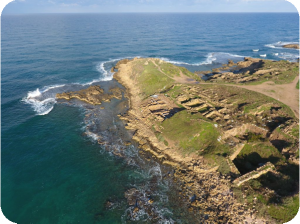Home - From Canaanites to 'Phoenicians' and 'Philistines':
Maritime Connectivity and Use of Coastal Resources as an Adaptation to Changing Political and Environmental Conditions CA. 2000-500 BCE

In the unstable Mediterranean climate, maritime connectivity such as trade and the movements of people, as well as the use of coastal and marine resources, may be seen as an adaptive strategy for risk management, implemented in tandem with the establishment of building blocks of specialized Mediterranean economy. Coastal communities are the meeting place for the study of two key themes in Mediterranean historical and archaeological research: agricultural adaptation and trade networks. These are inherently codependent as Mediterranean economic adaptation affects and is affected by the region’s climatic uncertainty. Complex interregional interactions occurring at coastal settlements—economic, sociocultural and others—can all be connected to this basic and fundamental economic adaptation, and can potentially be detected in the archaeological record: maritime remains such as shipwrecks, sunken cargoes and anchors; finds relating to the land/sea interface such as of port facilities; and terrestrial remains such as coastal architecture, coastal wells, markets, imported items and facilities for the processing of marine resources. At the same time, for communities occupying these interface zones, adaptation was not a static affair. Rather, fragility factors changed almost constantly with common risks of life in the eastern Mediterranean. These could be draughts and other short- and long-term changes in climate, as well as anthropogenic risks like the predation of neighboring communities, empires and other polities. Additional causes for fragility were typical of the coastal area, such as changes in sea level, the risk of tsunamis and even strong winter storms. These threats had the potential to impact severely specific modes of maritime adaptation, affecting marine and coastal infrastructure, from wells and coastal walls to quays and moles. This workgroup will look, therefore, at adaptation to coastal residence, subsistence and maritime connectivity not as a static feature, constant throughout history, but as a process that requires permanent adjustments due to changes in environmental, social and political conditions. It is thus the aim of this group to look at the longue durée of changes in maritime activities and other forms of adaptations to living by the sea during the period spanning the Middle Bronze Age to the end of the Iron Age (ca. 2000–500 BCE). Special attention will be given to the impact of two groups of variables: climate and sea level changes on the one hand, and fluctuations in political circumstances connected with the domination of empires, on the other.
This research group is organized and led by Prof. Assaf Yasur-Landau and Prof. Ayelet Gilboa of the University of Haifa. The group is supported through a generous grant from the Haifa Center for Mediterranean History (HCMH).
For more information, contact us:
Prof. Assaf Yasur-Landau, assafyasur@hotmail.com
Prof. Ayelet Gilboa, agilboa@research.haifa.ac.il

